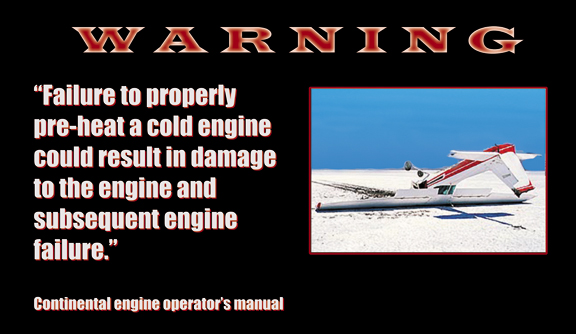

Why preheat your aircraft engine?
Teledyne-Continental Service Information Letter No. SIL 03-1 or the Continental Standard Practice Maintenance Manual M-0
COLD WEATHER OPERATION – ENGINE PREHEATINGhoses, and oil cooler with subsequent loss of oil flow, possible internal damage to the engine, and subsequent engine failure.Preheating is required whenever the engine has been exposed to temperatures at or below 20° Fahrenheit / -7 degrees Centigrade (wind chill factor) for a period of two hours or more.
Failure to properly preheat a cold-soaked engine may result in oil congealing within the engine, oil
Superficial application of preheat to a cold soaked engine can cause damage to the engine. An inadequate application of preheat may warm the engine enough to permit starting but will not de-congeal oil in the sump, lines, cooler, filter, etc. Congealed oil in these areas will require considerable preheat.
The engine may start and appear to run satisfactorily, but can be damaged from lack of lubrication due to the congealed oil blocking proper oil flow through the engine. The amount of damage will vary and may not become evident for many hours. However, the engine may be severely damaged and may fail shortly following application of high power. Proper procedures require thorough application of preheat to all parts of the engine.
Do not operate the engine at speeds above 1700 RPM unless oil temperature is 75°Fahrenheit or higher and oil pressure is within specified limits of 30-60 PSI.
Operation of the engine above 1700 RPM before reaching minimum oil temperature may result in engine malfunction, engine failure, injury or death.
Lycoming Service Instruction No. 1505 Cold Weather Starting
In extremely low temperatures, oil congeals, battery capacity is lowered, and the starter can be
overworked. Improper cold weather starting can result in abnormal engine wear, reduced performance, shortened time between overhauls, or failure for the engine to operate properly.The use of pre-heat will facilitate starting during cold weather, and is required when the engine has been
allowed to drop to temperatures below +10°F/-12°C (+20°F/-6°C for –76 series engine models).
Note the Continental and Lycoming preheat temperature requirements above are just MINIMUM standards. Just like many people change their oil more often than the engine manufacuters require, we advocate preheating more often than they require and suggest preheating whenever the engine is below 50 or 60F.
Harold Tucker, Director of Technical Information and Training, ConocoPhillips Commercial Lubricants:
"It is generally accepted that a cold startup is considered to be anything below 60 F. However, an engine at rest is always cold relative to its normal operating temperatures; therefore, the oil is also thick relative to its designed operating viscosity." <From Aircraft Maintenance Technology magazine, Sept 2008>
"There are several reasons that TBO is such a flawed concept. One is that engine life has very little to do with engine hours in service. Hours do not limit the life of our engines. The biggest life-limiting factor is exposure to corrosive environments during periods of disuse. The next biggest is operator abuse, particularly cold starts...". ("When to Overhaul" by Mike Busch, Sport Aviation magazine, Feb. 2012, pg 52)
Go here for Magazine Articles about preheating

"Why won't this @$#! thing start... I should have installed a Reiff Preheat System!!"
Main Page | Place an Order | Contact Us | FAQ
Last updated 2/15/12